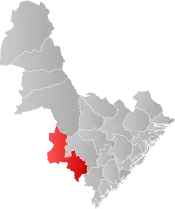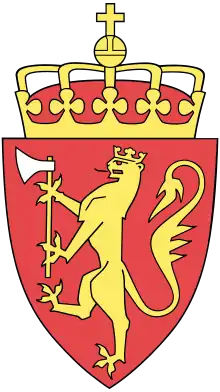Hornnes og Iveland
Hornnes og Iveland is a former municipality in the old Nedenæs county in Norway. The 640-square-kilometre (250 sq mi) municipality[1][2] existed from 1838 until its dissolution in 1886. It included all of the present-day municipality of Iveland and the western half of the present-day municipality of Evje og Hornnes in the Setesdal region of Agder county. The administrative centre was the village of Hornnes where the Hornnes Church is located. The other church in the municipality was the Iveland Church in the village of Birketveit.
Hornnes og Iveland herred | |
|---|---|
 Aust-Agder within Norway | |
 Hornnes og Iveland within Aust-Agder | |
| Coordinates: 58°33′33″N 07°46′24″E | |
| Country | Norway |
| County | Aust-Agder |
| District | Setesdal |
| Established | 1 Jan 1838 |
| Disestablished | 1 Jan 1886 |
| Administrative centre | Hornnes |
| Area | |
| • Total | 640 km2 (250 sq mi) |
| *Area at municipal dissolution. | |
| Population (1886) | |
| • Total | 2,216 |
| • Density | 3.5/km2 (9.0/sq mi) |
| Demonyms | Horndøl Ivelending[3] |
| Time zone | UTC+01:00 (CET) |
| • Summer (DST) | UTC+02:00 (CEST) |
| ISO 3166 code | NO-0935 |
| Created as | Formannskapsdistrikt in 1838 |
| Succeeded by | Hornnes and Iveland in 1886 |
History
The parish of Hordnæs og Iveland was established as a municipality on 1 January 1838 (see formannskapsdistrikt law). According to the 1835 census, the municipality had a population of 1,848.[4] On 1 January 1886, Hornnes og Iveland was divided to create two separate municipalities: Hornnes (population: 1,113) and Iveland (population: 1,103). The municipality of Iveland still exists today, while Hornnes currently a part of the municipality of Evje og Hornnes.[5]
Name
The municipality is an amalgamation of the names of two local parishes: Hornnes and Iveland.
The parish of Hornnes is named after an old Hornnes farm (Old Norse: Hornnes), since the first Hornnes Church was built there. The first element is horn which means "horn" and the last element is nes which means "headland". So the meaning of Hornnes is "the headland shaped like a horn".[6]
The parish of Iveland is named after the old Iveland farm (Old Norse: Ífuland), since the first Iveland Church was built there. The first element is the genitive case of the river name Ífa (now called the Frøysåna) and the last element is land which means "land" or "farm". The old river name is probably derived from the Norse word ýr which means "yew" (Taxus baccata).[7]
References
- Thorsnæs, Geir, ed. (10 July 2015). "Hornnes". Store norske leksikon (in Norwegian). Kunnskapsforlaget. Retrieved 22 May 2017.
- Thorsnæs, Geir, ed. (5 April 2016). "Iveland". Store norske leksikon (in Norwegian). Kunnskapsforlaget. Retrieved 22 May 2017.
- "Navn på steder og personer: Innbyggjarnamn" (in Norwegian). Språkrådet.
- "Hjemmehørende folkemengde Aust-Agder 1801-1960" (in Norwegian). University of Tromsø: Registreringssentral for historiske data.
- Jukvam, Dag (1999). "Historisk oversikt over endringer i kommune- og fylkesinndelingen" (PDF) (in Norwegian). Statistisk sentralbyrå.
- Rygh, Oluf (1905). Norske gaardnavne: Nedenes amt (in Norwegian) (8 ed.). Kristiania, Norge: W. C. Fabritius & sønners bogtrikkeri. p. 184.
- Rygh, Oluf (1905). Norske gaardnavne: Nedenes amt (in Norwegian) (8 ed.). Kristiania, Norge: W. C. Fabritius & sønners bogtrikkeri. p. 179.

